Trichogramma: Beneficial Wasps for Biological Pest Control

Hello to all agrohuerters! In today’s article we are going to introduce you to a type of beneficial wasp of the Trichogramma genus as one of the most widely used biological control methods. It is used against more than 28 species! How can these wasps help control our orchard pests?

Biological pest control with natural enemies: beneficial wasps
Biological control, as you already know, consists of using living organisms to control pests and diseases in the garden. It is one of the alternatives used to reduce the use of products that are harmful to the environment in agriculture. These beneficial organisms can be microorganisms or macro-organisms (also called » natural enemies»). Among them, there is a group of wasps known as Trichogramma that will be of great help in the garden to control some pests that we will see next.
Difference Between Parasitoid Insects and Predatory Insects
Before starting to tell you about these beneficial wasps for our garden, I would like to remind you of the difference between parasitoid insects and predators, since sometimes we get into trouble. Also, it can be summed up in that if the insects had to make a horror movie, they would use them as the main actors…
A predatory insect is one that normally has a lot of mobility when searching for and hunting its prey (it can hunt in a larval or adult state). They have different types of mouthparts (masticator or picador-suctor). An example of this type of insect is ladybugs, hoverflies, lacewings or spiders.

However, when we speak of parasitoid insects, as in the case of Trichogramma, we refer to a group of insects that lay eggs inside (endoparasitoids) or outside (ectoparasitoids) of an organism. These eggs will develop in a larval state inside the organism, consuming its reserves and causing death. Many species of Hymenoptera are parasitoids of aphids or orchard caterpillars. They can also parasitize eggs laid by insects, as in the case of Trichogramma.
What is Trichogramma?
Within the group of Hymenoptera (where the wasps, bees or ants are) there are many different families. One of them is the family of Trichogrammatidae, where the genus of Trichogramma is found. This genus is made up of small parasitoid wasps of insect eggs and sometimes less than 1 millimeter. There can be more than 200 different species!
How can you eliminate Trichogramma pests?
As we have seen before, these small beneficial wasps will look for where the garden insects lay their eggs and, once located, they will lay the eggs inside. Trichogramma larvae will develop inside these eggs, killing the embryos inside.
Once the larval stage and the nymphosis stage are over, the small wasp will emerge from the egg by making a small hole. We can differentiate the eggs that have been parasitized by these wasps as they turn black.
There are some species of Trichogramma that can parasitize more than 100 eggs throughout their lives and normally acts between the months of May to August.
Against what type of pests is Trichogramma used?
Trichogramma can attack many types of insects, including those that are problematic in the garden. However, their favorite species are the eggs of lepidoptera, such as corn borer, apple woodworm or cotton bollworm.
Corn borer (Ostrinia nobilalis)
It could be said that the corn borer is one of the most important pests in this crop. These caterpillars damage the ears and stalks of corn as they tunnel into them to feed.
Apple codling (Cydia pomonella)
Carpocapsa can become a very harmful pest for our apple trees. Winters as a caterpillar in trunk crevices and on tree branches. They can excavate galleries inside the fruit. The optimal conditions for mating are sunsets, temperatures greater than 15ºC. During the day, the adults are motionless in the trees.

Cotton bollworm (Helicoverpa zea)
As in the previous cases, the bollworm can cause serious damage to agriculture. In this case, the larvae attack the cotton crop but there are other species of the same genus such as Helicoverpa armigera that can attack tomato, corn, etc.
How to apply the Trichogramma product?
In stores you can find different products with this name and different application methods. For example, in capsules or in small cartons that are hung on the plants. They can be distributed manually or with more technical methods such as drones. Regarding the conditions and time of application you will find all the information on the container.
Here you can see an example of an open capsule inside which there are Trichogramma wasps.

As in most biological control methods, you can complement the use of these beneficial wasps with others such as Bacillus thuringiensis.
References
- Kalyanasundaram, M., Merlin Kamala, I. (2016). Chapter 4 – Parasitoids, Editor(s): Omkar. Ecofriendly Pest Management for Food Security, Academic Press, 109-138.
- Jalali, S.K., Mohanraj, P., Lakshmi, B.L. (2016). Chapter 5 – Trichogrammatids. Publisher(s): Omkar. Ecofriendly Pest Management for Food Security, Academic Press, 139-181.
- KOGAN, M., GERLING, D., MADDOX, J. (1999). CHAPTER 30 – Enhancement of Biological Control in Annual Agricultural Environments. Editor(s): Thomas S. Bellows, TW Fisher, Handbook of Biological Control, Academic Press, 789-818.
I hope that little by little we will learn the new methods against pest control in the garden and, as always, you can tell us in the comments if you already have experience using them.
Good morning everyone!



![Photo of The Zamioculcas: [Care, Planting, Irrigation, Substrate]](https://www.complete-gardening.com/wp-content/uploads/2022/08/the-zamioculcas-care-planting-irrigation-substrate-390x220.jpg)
![Photo of Plant Araucaria: [Care, Irrigation, Cultivation, Substrate]](https://www.complete-gardening.com/wp-content/uploads/2022/08/plant-araucaria-care-irrigation-cultivation-substrate-390x220.jpg)